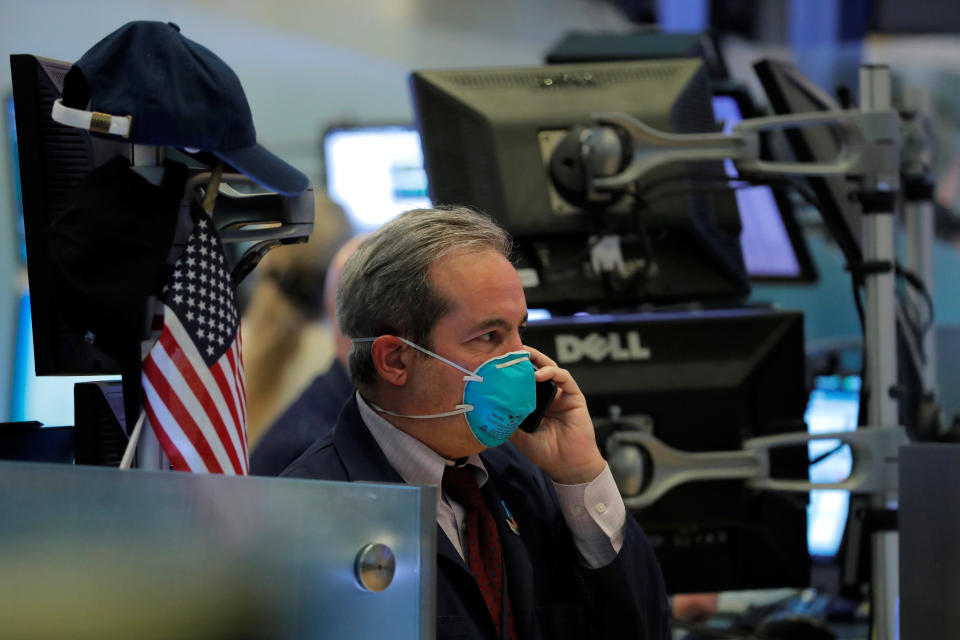Unprecedented: NYSE to go 'fully electronic' without floor traders on Monday, March 23
Businesses and communities across America are feeling negative effects from the coronavirus outbreak.
That includes the iconic New York Stock Exchange, which will mandate an empty NYSE trading floor starting Monday, March 23 while electronic trading continues for the first time ever.
“We are temporarily doing that as part of our business continuity planning,” John Tuttle, Vice-Chairman and Chief Commercial Officer, told Yahoo Finance (video above). “We expect uninterrupted service for NYSE listed companies for investors as well. But we believe it's the prudent move given the fluidity of the situation not only in New York City but around the world with regard to COVID-19.”
The move comes after two people tested positive for coronavirus during screenings set up by the NYSE. The NYSE equities trading floor and American Options trading floor in New York will be closed along with the NYSE Arca Options trading floor in San Francisco.

Tuttle is confident the NYSE is up to the task. The exchange regularly tests all systems, including the fully electronic systems and has a lot of redundancies in place.
“We operate various markets at the New York Stock Exchange,” he said. “In fact, we already operate two fully electronic listing venues in NYSE Arca and NYSE American. So shifting the NYSE to a purely electronic platform is not something that's going to be new for us. We operate electronic markets flawlessly. We test our markets as well for moments like this.”
He continued: “So from our standpoint, many of the market participants that are there on the floor in a given day, we'll be participating electronically and remotely. And they're going to be there with the same liquidity requirements and the same accountability that they would have if they were on our 11 Wall Street building.”
The S&P and the Dow have seen wild double-digit percentage swings in the past few weeks in, and that volatility is expected to continue.
“This is really what our market model was purpose built for,” Tuttle said. “It's to help dampen volatility and provide liquidity in these moments. And from our standpoint, given the tremendous uptick in messaging and volumes as well, our systems have performed remarkably well.”

Slowdown in IPO Market
Tuttle also discussed the slowdown in the IPO pipeline.
“Going through an IPO, you want to de-risk as much as possible, you want to minimize as much uncertainty as possible,” he said. “So given that, again, the fluidity of the situation day by day, week by week, companies and investors would like to have a little bit more certainty about what the environment would look like.”
He added that “part of going public is meeting with investors. Sure, that can be done virtually and probably effectively, but it still doesn't replace those face to face meetings when companies go on the roadshow and number three in the markets are volatile, when when the markets are volatile, you see fewer IPOs. That's just been a historic trend. Frankly, a fact.”

End of an era?
Over the years, there’s been less and less traders on the floor of the NYSE. Some even feared losing their jobs to computers. When asked “Will this be the end of an era?” Tuttle answered: “Absolutely not.”
“You know, we believe and the data fully supports that human beings interacting with increasingly sophisticated technology brings about the best outcomes, that's for listed companies,” he said. “That's for investors. And so when the time is right, and we'll continue to monitor events to determine when that is we look forward to reopening our iconic trading floor and bringing those services back to the marketplace.”
There is no timeline for when the NYSE will allow traders back into 11 Wall Street.
“Given the fluidity of the situation, we can see how much has changed not only in the course of the past week, but the past day as well,” Tuttle said. “We'll continue to monitor the events closely and make a decision when the time is right.”
—
Lulu Chiang is a senior executive producer at Yahoo Finance.
Read more:
JPMorgan Foundation President: It's 'paramount' to help small businesses amid the coronavirus
Why businesses might ‘walk away’ from Trump’s coronavirus aid
Read the latest financial and business news from Yahoo Finance
Follow Yahoo Finance on Twitter, Facebook, Instagram, Flipboard, LinkedIn, and reddit.

